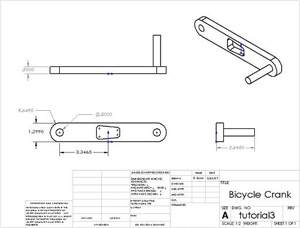Author: Rajesh Bhaskaran, Cornell University
Problem Specification
[1. Start-up and preliminary set-up]
[2. Specify element type and constants]
[3. Specify material properties]
[4. Specify geometry]
[5. Mesh geometry]
[6. Specify boundary conditions]
[7. Solve\!]
[8. Postprocess the results]
[9. Validate the results]
Problem Specification
Geometry
A preeminent bicycle company is disappointed with the negative feedback they have received on their latest model, and they have pinpointed the problem to an outdated bicycle crank design that they assumed would still withstand typical loads. To protect their reputation, they have outsourced the task of analyzing the crank to you, providing you with the geometry shown below. The dimensions are given in inches. The material they selected has an Young's modulus E = 2.8x107 psi and Poisson ratio ν=0.3.

[click here for full view|^crankDiagram.jpg]
Using ANSYS, determine the mechanical response due to a load of 100 lbf applied vertically downward at the end of the pedal shaft as shown in the figure below. Assume that the crank is attached rigidly to a fixed shaft fitted into the hole near the left end of the crank as indicated in the figure.

Using ANSYS, calculate the deflection, strain and stress distributions for this loading condition. use the results to evaluate the degree of stress concentration in the vicinity of the cut-out in the crank geometry.
[*Go to Step 1: Start-up and preliminary set-up*]
[See and rate the complete Learning Module]
 Sign-up for free online course on ANSYS simulations!
Sign-up for free online course on ANSYS simulations!